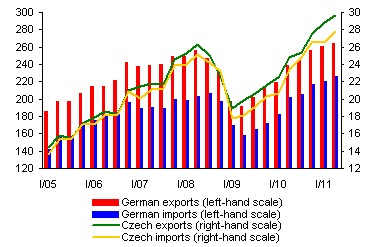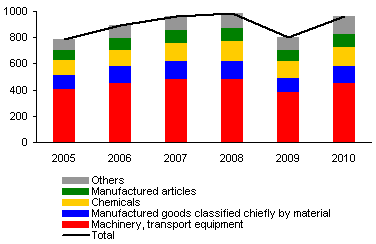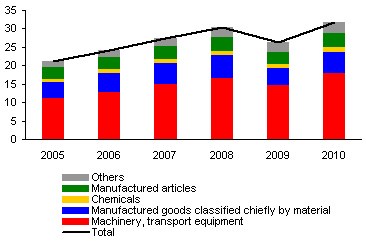Germany – the Czech Republic’s main trading partner
The German economy has a trade surplus vis-à-vis all its major trading partner countries except China. This merely confirms Germany’s status as the “export engine” of the euro area, i.e. its key role on the European scale. The strongly export-oriented Czech economy’s links with the German economy are therefore crucial.
In the last five years, Germany has accounted for more than 29% of Czech foreign trade turnover. Out of all its trading partners, the Czech Republic’s trade surplus with Germany has also been the highest in the same period. This surplus has risen steadily and now exceeds the Czech Republic’s overall trade surplus. The interdependence of Czech goods exports and German goods imports and exports is very high (see Chart 1). The same can also be observed for Czech goods imports as a result of strong collaboration imports.1) The share of goods exports to Germany was 31.6% on average, with the highest share (32.5%) having been recorded in 2009, i.e. during the deepest phase of the financial crisis.
Chart 1 (Box) Exports and imports of Germany and the Czech Republic
The foreign trade of the Czech Republic and Germany is highly interdependent
(EUR billions; source: CZSO, Destatis, CNB calculation)

The strong link between German and Czech exports is also reflected in their structure. Machinery and transport equipment is the largest item of German exports, accounting for around 50% of the total (see Chart 2). Goods exports from the Czech Republic to Germany have a similar structure and are also dominated by machinery and equipment (see Chart 3).
Chart 2 (Box) Commodity structure of Germany exports
Machinery and transport equipment is the largest item of German goods exports
(EUR billions; source: Destatis, CNB calculation)

Chart 3 (Box) Commodity structure of Czech exports to Germany
Machinery and transport equipment accounts for more than 50% of total Czech goods exports to Germany
(EUR billions; source: Destatis, CNB calculation)

Given the Czech economy’s strong links with Germany and other EU countries, economic developments in these countries feed through rapidly to the Czech economy via exports. A downturn in external demand, usually accompanied by a decrease in foreign interest rates, has an immediate downward effect on domestic GDP growth. Domestic interest rates also decline in response to lower foreign rates and lower domestic cost pressures. In the initial phase, the weakening inflation pressures stemming from lower domestic GDP and business sector wages are outweighed by depreciation of the koruna resulting from worsening net exports. The slowdown in consumer price inflation thus occurs with a lag, despite the slowdown in domestic economic activity. In the next phase, the weaker koruna fosters a rise in net exports via increasing price competitiveness of domestic producers, but it only moderates the effect of the contraction in external demand.2)
1)However, no interdependence has been proven between the Czech trade balance and the German trade balance.
2)Alternative scenarios regarding the external environment and their impacts on the Czech economy are quantified in Inflation Report I/2011 and in this Inflation Report IV/2011 (see section II.4).